Library Art Exhibits Appeal To Our Sense of Nostalgia

B%20giuseppe%20luciani%20clinton%20hill_2.jpg
Brooklyn Street Scenes, Details of Famous Buildings
BROOKLYN — Like other cultural institutions, The Brooklyn Public Library has exhibitions — works of art and culture in the display cases around the Central Library. And the works of the current group of artists, which will be on display through Feb. 18, appeal to the child in all of us.
“Brooklyn Views” by Giuseppe Luciani, “The Other Bushwick” by Bob Rothstein, Leslie Sutcliffe’s “Reading Images” and Isabel Hill’s “Building Stories” offer different visual languages to understand their world views.